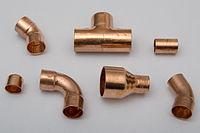
Photo from wikipedia
Fluid-driven soft robots offer many advantages over robots driven by other means in terms of universal preparation processes and high-power density ratios, but are largely limited by their inherit characteristics… Click to show full abstract
Fluid-driven soft robots offer many advantages over robots driven by other means in terms of universal preparation processes and high-power density ratios, but are largely limited by their inherit characteristics of rigid pressure sources, fluid control elements and complex fluid pipelines. In this paper, inspired by the principle of biofluid control and actuation, we combine simulation analysis and experimental validation to conduct a bionic design study of an efficient flexible fluid control valve with different actuation diaphragm structures. Under critical flexural load, the flexible valve undergoes a continuous flexural instability overturning process, generating a wide range of displacements. The sensitivity of the flexible valve can be improved by adjusting the diaphragm geometry parameters. The results show that the diaphragm wall thickness is positively correlated with the overturning critical pressure, and the radius of curvature is negatively correlated with the overturning critical pressure. When the wall thickness of the flexible valve maintains the same value, as the radius of curvature increases, the critical buckling load and recovery load of diaphragm overturning is a quadratic function of opposite opening, and the pressure difference converges to the minimum value at the radius of curvature R = 7.
Journal Title: Biomimetics
Year Published: 2022
Link to full text (if available)
Share on Social Media: Sign Up to like & get
recommendations!